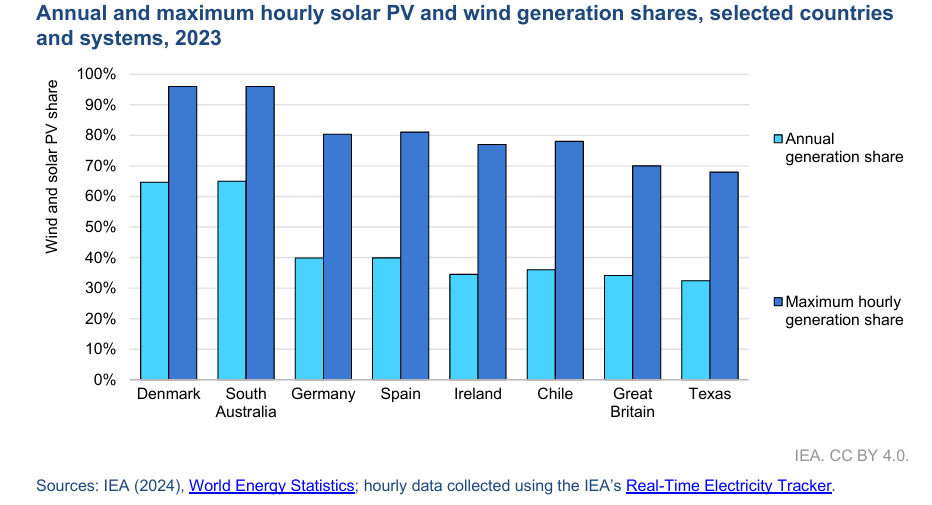At a glance
“Integrating Solar and Wind: Global experience and emerging challenges,” by Rena Kuwahata, Javier Jorquera Copier and Pablo Hevia-Koch. International Energy Agency (IEA), Sept. 18, 2024.
This IEA report examines the urgent need for timely integration of solar photovoltaic (PV) and wind power to achieve global decarbonization. It warns that failing to bring in proper integration measures could jeopardize up to 15 per cent of solar and wind generation by 2030, potentially leading to a 20 per cent smaller reduction in carbon dioxide emissions for the power sector. This comprehensive stocktake of variable renewable energy (VRE) integration across 50 power systems also identifies proven strategies and updates the IEA’s integration framework to guide policymakers.
These findings underscore the critical importance of strategic government action, enhanced infrastructure, and regulatory reforms to ensure the successful large-scale integration of renewables, which is essential to meeting global climate targets and shaping a sustainable energy future.
Organizations
Topics
Key findings
- Capacity growth: Solar and wind capacity more than doubled between 2018 and 2023, nearly doubling their share of global electricity generation.
- Integration is important: By 2030, up to 15 per cent of solar and wind energy generation could be lost without proper integration measures. This could reduce the power sector’s emissions cuts by 20 per cent.
- Concentrated generation: Nearly 90 per cent of global solar and wind generation comes from 50 power systems, many of which are facing significant integration challenges.
- Future capacity: Systems in early phases of renewable integration are expected to account for two-thirds of additional solar and wind capacity by 2030.
- Advanced systems: Denmark and South Australia are advanced systems that already handle over 30 per cent of annual generation from solar and wind energy.
- Investment need: Global grid investment must double by 2030 to meet expanding renewable energy capacity demands and ensure system stability.
Take a look

Bigger picture
The challenge of integrating solar and wind energy into power grids is one that needs solving. While renewable capacity is growing rapidly, particularly in emerging markets, the energy transition hinges on effective integration strategies. Without proper integration, much renewable energy potential could be wasted, delaying progress towards reducing emissions and meeting climate pledges.
The report notes that both advanced economies and developing regions face unique challenges in renewable integration. While frontrunners such as Denmark and South Australia have made significant strides in managing high levels of wind and solar power, emerging markets in Asia, Africa, and Latin America will need targeted measures to avoid grid instability. Industries involved in energy storage, grid technology and demand management will play an increasingly critical role in supporting renewable energy expansion.
Looking ahead, the report signals a global shift towards greater investment in grid infrastructure and flexibility solutions, such as energy storage and demand response. Countries and industries that prioritize these areas will be better positioned to capitalize on renewable energy growth while maintaining system reliability. The report underscores the urgency of addressing integration challenges now, to meet climate targets and to support the continued cost-effectiveness and expansion of renewable energy worldwide.
Challenges and opportunities
Key barriers to integrating solar and wind into power systems:
- Policy and regulatory hurdles: Inconsistent policies delay renewable adoption, so governments must establish clear, streamlined regulations.
- Infrastructure constraints: Grid congestion and connection delays hinder progress. Doubling global grid investment by 2030 is critical.
- Financing challenges: High upgrade costs slow renewable scaling, especially in developing countries. Public-private partnerships can help bridge financing gaps.
- Technology gaps: Lack of advanced storage and demand response technologies limits grid flexibility. Incentivizing innovation in these areas is essential.
- Co-ordination issues: Fragmented policy implementation slows integration. Increased international collaboration can improve knowledge sharing and reduce delays.
- Grid flexibility limitations: Power systems struggle to manage solar and wind variability. Smart grids and energy storage must be prioritized by utilities and governments.
To address these challenges, the report recommends:
- Grid investment: Accelerate infrastructure upgrades and expansion globally and invest in advanced control systems and operational practices to manage increased complexity.
- Technology innovation: Technology providers should develop areas such as advanced forecasting, energy storage, and smart grid solutions.
- Policy alignment: Regulators need to adapt market rules and grid codes and create clear, predictable integration policies that align with energy transition goals.
- Cross-border collaboration: Share best practices to help emerging markets adopt proven solutions.
- Public-private partnerships: Foster collaboration to drive innovation and fund renewable integration projects.
- Smart grid modernization: Deploy smart grids and digital solutions to optimize renewable energy integration.
In their own words
This report emphasises that while systems at early phases of VRE integration can accelerate deployment with relatively low system impact, those in high phases face more complex challenges related to stability and flexibility, which call for a transformation of how power systems are operated, planned and financed.
Integrating Solar and Wind, by Rena Kuwahata, Javier Jorquera Copier and
Pablo Hevia-Koch et all. International Energy Agency, September 2024.
Final thoughts
The report highlights the critical need to integrate solar and wind energy into global power systems to meet climate targets, with up to 15 per cent of renewable energy generation at risk by 2030 without timely infrastructure upgrades. It underscores that while many countries, especially in emerging markets, are in the early stages of renewable integration, the technical challenges and grid stability issues faced by advanced systems offer valuable lessons for global energy transition efforts.
However, the report could have explored more on emerging technologies like green hydrogen, the role of decentralized energy systems in complementing solar and wind integration, and the socioeconomic impacts of VRE integration, particularly in emerging economies where energy access and development goals intersect. To accelerate the path to net zero, governments and industries must collaborate on large-scale grid modernization, regulatory reform, and innovative storage solutions across regions and sectors.
— By Charlie Bush
Download the full report originally published by the International Energy Agency on Sept. 18, 2024.












